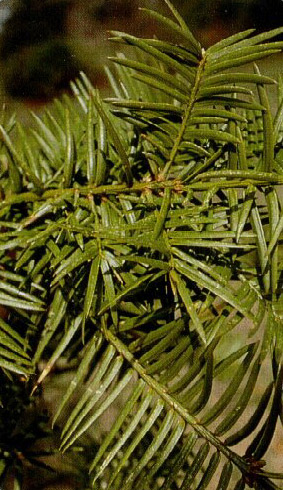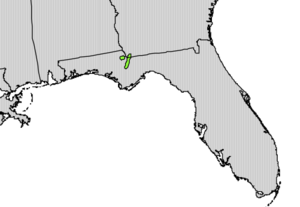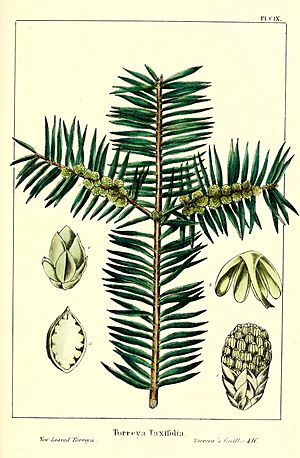Florida torreya facts for kids
Quick facts for kids Florida torreya |
|
|---|---|
 |
|
| Leaves of Torreya taxifolia | |
| Conservation status | |
| Scientific classification | |
| Genus: |
Torreya
|
| Species: |
taxifolia
|
 |
|
| Native range | |
| Synonyms | |
|
|
The Torreya taxifolia, also known as the stinking-cedar or Florida torreya, is a rare tree. It belongs to the yew family (Taxaceae). This tree is found in the southeastern United States, specifically near the border of northern Florida and southwestern Georgia.
This tree is in great danger. It was one of the first plants in the U.S. to be listed as endangered in 1984. The IUCN has called it critically endangered since 1998. By 2010, about 98% of the older trees were thought to have died. This was mainly due to a mysterious fungal disease. Other problems included flooding from dams and damage from deer rubbing their antlers on the trees.
Contents
About the Florida Torreya
Discovery and Naming
In the early 1800s, a man named Hardy Bryan Croom was exploring the lands around Tallahassee, Florida. He was very interested in botany, which is the study of plants. In 1833, he found a unique tree and sent samples to a famous botanist named John Torrey.
Torrey realized that this tree was a new species, meaning it had never been scientifically described before. In 1838, another botanist, George Arnott Walker-Arnott, officially described the new species. He named the genus Torreya to honor John Torrey. The second part of the name, taxifolia, comes from Latin words. Taxus means 'yew', and folium means 'leaf'. So, Torreya taxifolia means 'Torrey's yew-leaved tree'.
Common Names
This tree has several interesting common names. It is often called stinking-cedar because its wood has a strong, unique smell, especially when it's cut or burned. People also call it gopher wood or Florida nutmeg. The name "nutmeg" comes from its seeds, which are covered in a fleshy layer and look a bit like large nutmegs.
What the Florida Torreya Looks Like
The Florida torreya is an evergreen tree. This means it keeps its leaves all year round. It can grow up to 18 meters (about 59 feet) tall. Its trunk can be as wide as 80 centimeters (about 31 inches). However, most trees today are much smaller, often less than 3 meters (10 feet) tall.
Its branches spread out, giving the tree a cone shape. The leaves are like stiff needles, about 1.5 to 3.8 centimeters (0.6 to 1.5 inches) long. They are sharp to the touch. The leaves are shiny green on top and lighter green underneath. If you crush the leaves, they release a strong, unpleasant smell.
Reproduction
Florida torreya trees have separate male and female plants. This is called being dioecious. Male plants produce pollen cones, which are small and look like those of a common yew. Female plants produce seed cones. These cones grow into a fruit-like structure with a single large, nut-like seed inside. The seed is covered by a fleshy layer called an aril. This aril is dark green and turns purple when ripe. Unlike true yews, where the aril forms a cup, here it completely covers the seed.
Where the Florida Torreya Lives
The Florida torreya naturally grows in a very small area. It is found along the east bank of the Apalachicola River. This area is in the northern part of the Florida Panhandle and a small part of southern Georgia. It likes to grow on limestone bluffs and in deep ravines. These places often have moist, dark soils and are usually shaded by larger trees.
The total area where it naturally grows is only about 203 square kilometers (about 78 square miles). This stretches about 35 kilometers (22 miles) along the Apalachicola River. There is also a very small group of trees west of the river.
Some Florida torreya trees have been planted in other places, like the Biltmore Estate in Asheville, North Carolina. These trees were planted for decoration.
Habitat and Neighbors
This tree grows in two main types of forests: oak-tupelo-cypress forests or oak-pine forests. These forests have many deciduous trees (which lose their leaves in fall) and also some evergreens. Common trees found with the torreya include American beech, tulip tree, sweetgum, and various oaks and pines.
Another rare conifer, the Florida yew (Taxus floridana), sometimes grows alongside the Florida torreya. The ravines where it lives are also home to unique animals, like a rare salamander called Desmognathus apalachicolae.
Animals like rodents and squirrels eat the seeds of the Florida torreya. Squirrels often bury the seeds in caches for winter. Sometimes, these buried seeds can sprout into new trees.
Uses of the Florida Torreya
The wood of the Florida torreya is very beautiful. It is yellow, strong, light, and lasts a long time. In the 1800s, people used this wood for many things. They made fence posts, shingles, and cabinets. It was also used as firewood and fuel for riverboats on the Apalachicola River. Fences made from this wood in the early 1900s were still in good condition decades later.
When the tree's trunk is damaged, it can produce a small amount of sticky, red liquid called turpentine. This liquid has a very strong and unpleasant smell.
Growing the Tree
The Florida torreya is often planted in gardens and botanical parks outside its natural home. It was first brought to Europe in 1840. While it can survive in cooler climates, it grows very slowly in places like Britain.
Some large Florida torreya trees are grown in botanical gardens. The tallest known tree of this species is in a private garden in Norlina, North Carolina. In 1996, it was about 13.7 meters (45 feet) tall. This tree can handle cold winter temperatures, even as low as -31 degrees Celsius (-24 degrees Fahrenheit).
Protecting the Florida Torreya
The main reason the Florida torreya is in danger is a fungal disease. This disease causes yellowish spots on the leaves. The spots spread, making the leaves turn brown and fall off. Eventually, the disease can kill the whole tree. Young trees are also affected, but usually not as badly. Trees growing in the shade seem to get sick more easily than those in full sunlight.
Scientists have been studying this disease for many years. In 1985, a scientist named Nabih Elias El-Gholl proved that a fungus called Gibberella baccata causes the leaf spots. However, the fungus that causes stem cankers (swollen, open sores on the stems) is still not fully understood.
Besides the fungal disease, deer also pose a threat. Deer like to rub their new antlers on young torreya trees, which can kill them. Wild pigs can also uproot and destroy seedlings. Changes in water levels due to dams, like the Jim Woodruff Dam, have also killed many trees by flooding their habitat.
Conservation Efforts
The Florida torreya was listed as an endangered plant in the United States in 1984. It is one of only two conifer species protected under the Endangered Species Act. It is also listed as "critically endangered" by the IUCN Red List.
In 1986, the U.S. Fish and Wildlife Service created a plan to help the tree recover. The main goal is to grow many genetically diverse trees and then plant them back in the wild. They also want to protect the remaining wild trees and study the disease.
Organizations like the Center for Plant Conservation and the Atlanta Botanical Garden are working to save the species. They grow seedlings and cuttings and plant them in safe places, both inside and outside the tree's natural range. Trees grown outside their native area often do not get the fungal disease and can produce healthy seeds.
Some people believe that humans should help the tree move to new, cooler areas, especially in the southern Appalachian Mountains. This idea is called "assisted migration." It is thought that the tree might do better in these cooler climates, as an introduced population in North Carolina is thriving and reproducing naturally. This project is a topic of debate among conservationists.
Protected Areas
Many of the remaining wild Florida torreya trees are protected. They live in Torreya State Park and at the Nature Conservancy's Apalachicola Bluffs and Ravines Preserve. These areas help safeguard the tree's natural habitat.
Images for kids
See also
 In Spanish: Torreya taxifolia para niños
In Spanish: Torreya taxifolia para niños






